Dragonball theme by jokerdeuce
Download: Dragonball.p3t
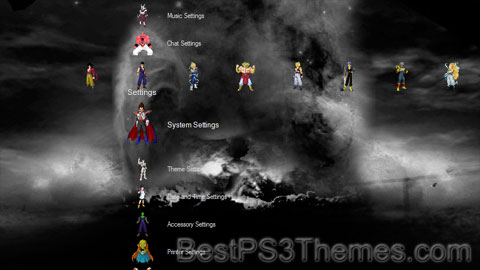
(1 background)
Redirect to:

The #1 spot for Playstation themes!
Sin City theme by Daniel Keen
Download: SinCity_2.p3t
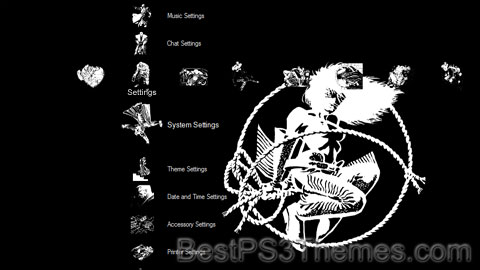
(13 backgrounds)
Sin City is a series of neo-noir comics by American comic book writer-artist Frank Miller. The first story originally appeared in Dark Horse Presents Fifth Anniversary Special (April 1991), and continued in Dark Horse Presents #51–62 from May 1991 to June 1992, under the title of Sin City, serialized in thirteen parts. Several other stories of variable lengths have followed. The intertwining stories, with frequently recurring characters, take place in Basin City.
A film adaptation of Sin City, co-directed by Robert Rodriguez and Frank Miller, was released on April 1, 2005. A sequel, Sin City: A Dame to Kill For, was released on August 22, 2014.
Writer-artist Frank Miller rose to fame within the American comics industry with his 1981–1983 work on Marvel Comics' Daredevil, and the 1986 DC Comics miniseries The Dark Knight Returns, both of which exhibited subtle elements of film noir.[1] Miller's venture into the film noir genre deepened with his creator-owned series Sin City, which began publishing in serialized form in the Dark Horse Comics anthology series Dark Horse Presents #51–62. The story was released in a trade paperback and later re-released in 1995 under the name Sin City: The Hard Goodbye.
In a 2016 interview with the Kubert School, Miller explained his inspiration for Sin City thus:
I've been a fanatic for a long time for old crime movies and old crime novels. But it started with the movies. And the old Cagney movies. Bogart and all that. I loved just how the morals of the stories are. They're all about right and wrong. But in Sin City in particular I wanted them all to happen to in a world where virtuous behavior was rare, which greatly resembled the world I lived in. It's kinda like the old Rolling Stones song, where every cop's a criminal, and all the sinners are saints, where the lowlifes would often be heroic, and the most stridently beautiful and sweet women would be prostitutes. I wanted it to be a world out of balance, where virtue is defined by individuals in difficult situations, not by an overwhelming sense of goodness that was somehow governed by this godlike Comics Code.[2]
The film noir influence on the series' artwork[1][3][4][5] is seen in its use of shadow and stark backgrounds. Black and white are the sole colors most of the time, with exception of red, yellow, blue, and pink, of which limited use is made in some stories to draw attention to particular characters.[1][6]
The writing style also draws heavily on detective and crime pulp fiction.[3][7][8]
Miller's Sin City work challenges some conventions of comic book form. The letters of onomatopoeic words like "blam" are often incorporated into scenes via lighting effects, or are suggested by the negative space between panels, or are created by the outline of the panels themselves. This is especially evident in early "yarns," such as The Hard Goodbye, which were more experimental.[9]
On April 28, 2022, it was officially announced that Miller was launching the comic book publishing company Frank Miller Presents (FMP), with one of his initial contributions being a Western tale set in Sin City's past, titled Sin City 1858.[10]

Basin City, almost universally referred to by the nickname "Sin City", is a fictional town in the Western United States. The climate is hot and arid, although Sacred Oaks[clarification needed] is characterized as being heavily wooded. A major river runs through the city, which has an extensive waterfront. Usually twice a year, a major downpour comes, and the city is prone to heavy snowfall in the winter. Desert lizards and palm trees are common, while tar pits, desert areas, mountain ranges and flat farmland make up the landscape around the city.[citation needed]
The Basin City Police Department are more or less along the lines of paramilitary or SWAT, as they have to deal with incredibly high crime rates among criminals and civilians alike, which is why they have access to what most would consider "heavy weaponry" and full body armor. Those who make up the force have been described as commonly being lazy, cowardly and/or corrupt. Only a handful of the cops are honest, though frequently the wealthy of the city bribe the corrupt members of the police into performing their duty (usually as a result of some crime being committed or threatened against a member of their family).[citation needed]
During the California Gold Rush, the Roark family "imported" a large number of attractive women to keep the miners happy, making a fortune and turning a struggling mining camp into a thriving, bustling city. Over the years, as the Roark family migrated into other areas of business and power, these women ended up forming the district of Old Town, the prostitute quarter of the city where they rule with absolute authority. In addition, the people charged with governing the city, most of them from the Roark line, remained in power for generations, running it as they saw fit.[citation needed]
As the various yarns progress, the audience gradually becomes familiar with key locations in and around Basin City:
Because a large majority of the residents of Basin City are criminals, there are several organizations and cartels central to the stories who are vying for monopoly over the various criminal enterprises in the city. Listed below are crime syndicates, gangs and other low-lifes who figure heavily in the Sin City mythos.
The Basin City Police Department: So deep does corruption and criminality run in Basin City that even their police officers qualify as a gang of paid thugs, turning a blind eye to the affairs of those too poor to pay them off. Few among them are considered incorruptible; even the honest officers are unable (or unwilling) to curtail the criminal actions of the dishonest ones. Notable characters in the series who are police include Detective John Hartigan, his partner Bob, Lieutenants Jack Rafferty and Mort, Commissioner Liebowitz, and Officers Manson and Bundy from Hell and Back.
Roark family: A dynasty of corrupt landowners and politicians whose influence over Basin City has stretched as far back as the days of the Old West. Famous Roarks of this generation include a senator, a cardinal, an attorney general, and Roark Junior, 'That Yellow Bastard'.
The Girls of Old Town: Populating the region of Basin City known as Old Town is a group of women in the world's oldest profession, having made a truce with the cops to allow them to govern and police themselves. As of A Dame to Kill For, they were led by the twins, Goldie and Wendy.
Wallenquist Organization: A powerful crime syndicate led by Herr Wallenquist, a mysterious crime lord with a broad range of criminal enterprises to his name. Although they are one of the city's two "normal" criminal organizations, the Wallenquist management seems to be the most peaceful and forgiving of the various leaders. It is unknown which crime rings they hold.
Magliozzi Crime Family: The undisputed heads of the local Cosa Nostra, the Magliozzi family seems to be the purest example of "true" Mafia lifestyle. While they appear in only one story, it is hinted that the Mafia influence in Basin City's underworld is a lot larger than just their family and that there are more families.
Other groups that have been seen or mentioned in the comics include:
Tong gangsters: Mentioned, but not seen as of A Dame to Kill For. Miho's life was saved by Dwight when he secretly protected her during a fight with several Tong gangsters in a dark alleyway.
White slavers: Mentioned, but not seen as of A Dame to Kill For. Led by a man named Manuel, whose brothers were also involved. Were "taken care of" by Dwight prior to the events of A Dame to Kill For.
Irish mercenaries: Seen during The Big Fat Kill, most of them are evidently former IRA members, as implied by one of the mercenaries referring to his glee at blowing up a public house (British pubs were targeted by the IRA). All are killed by Dwight and Miho.
These are the individual stories, usually referred to as "yarns," set in Frank Miller's Sin City universe.
The stories have been collected into a number of trade paperbacks and hardcover editions. There is also a collection of art, The Art of Sin City.
In 2016, Dark Horse Comics released an ambitious, oversized edition titled Frank Miller’s Sin City The Hard Goodbye Curator’s Collection.[11] This 15 x 21 inch book reprints the entire first storyline, scanned and reproduced exactly from the original art at 1:1 size. When referencing the production process in an interview with Michael Dooley for Print Magazine, editor/designer John Lind gave the anecdote “When Frank and I first reviewed some of the scanned pages from Sin City, he pulled one aside and said, ‘You can see details in some of the scans where you can tell what the humidity was like when I was lettering because you can see the smudging from my hand.’ That type of reaction represents the level of detail I'm working hard to achieve with the production.[12]
| Name | Contents | ISBN |
|---|---|---|
| The Hard Goodbye | Episodes #1–13 of 13 from Dark Horse 5th Anniversary Special and Dark Horse Presents issues #51–62 | ISBN 1-59307-293-7 |
| A Dame to Kill For | Issues #1–6 of 6 | ISBN 1-59307-294-5 |
| The Big Fat Kill | Issues #1–5 of 5 | ISBN 1-59307-295-3 |
| That Yellow Bastard | Issues #1–6 of 6 | ISBN 1-59307-296-1 |
| Family Values | 128-page original graphic novel | ISBN 1-59307-297-X |
| Booze, Broads, & Bullets | A number of one-shots | ISBN 1-59307-298-8 |
| Hell and Back | Issues #1–9 of 9 | ISBN 1-59307-299-6 |
| Name | Contents | Release Date | ISBN |
|---|---|---|---|
| Frank Miller's Sin City Library Set Vol. 1 | The Hard Goodbye, A Dame to Kill For, The Big Fat Kill and That Yellow Bastard | December 2005 | 978-1-59307-421-0 |
| Frank Miller's Sin City Library Set Vol. 2 | Family Values, Booze, Broads and Bullets, Hell and Back, and The Art of Sin City | June 2006 | 978-1-59307-422-7 |
| Big Damn Sin City | The Hard Goodbye, A Dame to Kill For, The Big Fat Kill, That Yellow Bastard, Family Values, Booze, Broads and Bullets, Hell and Back, and The Art of Sin City | June 2014 | 978-1-61655-237-4 |
| Frank Miller's Sin City Vol.1: The Hard Goodbye Curator's Edition | The Hard Goodbye scanned from the original artwork in Frank Miller's archives and reproduced at full size. Introduction by Robert Rodriguez, with an afterword by Mike Richardson and an interview about the artistic process with Frank Miller. | August 2016 | 978-1-50670-070-0 |
| Frank Miller's Sin City Vol.1: The Hard Goodbye Deluxe Edition | Episodes #1–13 of 13 from Dark Horse 5th Anniversary Special and Dark Horse Presents issues #51–62 | November 2021 | 978-1-50672-837-7 |
| Frank Miller's Sin City Vol.2: A Dame to Kill For Deluxe Edition | Issues #1–6 of 6 | December 2021 | 978-1-50672-838-4 |
| Frank Miller's Sin City Vol.3: The Big Fat Kill Deluxe Edition | Issues #1–5 of 5 | February 2022 | 978-1-50672-839-1 |
| Frank Miller's Sin City Vol.4: That Yellow Bastard Deluxe Edition | Issues #1–6 of 6 | May 2022 | 978-1-50672-840-7 |
| Frank Miller's Sin City Vol.5: Family Values Deluxe Edition | 128-page original graphic novel | June 2022 | 978-1-50672-841-4 |
A film adaptation of Sin City, co-directed by Robert Rodriguez and Frank Miller, was released on April 1, 2005. A sequel, Sin City: A Dame to Kill For, was released on August 22, 2014.
Dimension Films planned to develop a soft reboot of the series for television; Stephen L’Heureux who produced the second film was to oversee the series with Sin City creator Frank Miller.[13] The new TV series would feature new characters and timelines and be more like the comics rather than the films.[14] On November 15, 2019, Legendary Pictures bought the rights for the television series.[15]
South Park Unlimited! theme by Jeffrey Schipper a.k.a Ubiytsa
Download: SouthParkUnlimited.p3t
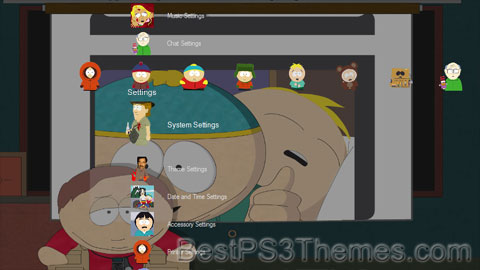
(13 backgrounds)
P3T Unpacker v0.12
Copyright (c) 2007. Anoop Menon
This program unpacks Playstation 3 Theme files (.p3t) so that you can touch-up an existing theme to your likings or use a certain wallpaper from it (as many themes have multiple). But remember, if you use content from another theme and release it, be sure to give credit!
Download for Windows: p3textractor.zip
Instructions:
Download p3textractor.zip from above. Extract the files to a folder with a program such as WinZip or WinRAR. Now there are multiple ways to extract the theme.
The first way is to simply open the p3t file with p3textractor.exe. If you don’t know how to do this, right click the p3t file and select Open With. Alternatively, open the p3t file and it will ask you to select a program to open with. Click Browse and find p3textractor.exe from where you previously extracted it to. It will open CMD and extract the theme to extracted.[filename]. After that, all you need to do for any future p3t files is open them and it will extract.
The second way is very simple. Just drag the p3t file to p3textractor.exe. It will open CMD and extract the theme to extracted.[filename].
For the third way, first put the p3t file you want to extract into the same folder as p3textractor.exe. Open CMD and browse to the folder with p3extractor.exe. Enter the following:
p3textractor filename.p3t [destination path]Replace filename with the name of the p3t file, and replace [destination path] with the name of the folder you want the files to be extracted to. A destination path is not required. By default it will extract to extracted.filename.
Bleach RELOADED versionD theme by Deemy
Download: BleachRELOADED_versionD.p3t
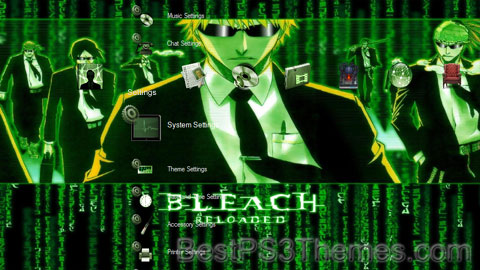
(1 background)
P3T Unpacker v0.12
Copyright (c) 2007. Anoop Menon
This program unpacks Playstation 3 Theme files (.p3t) so that you can touch-up an existing theme to your likings or use a certain wallpaper from it (as many themes have multiple). But remember, if you use content from another theme and release it, be sure to give credit!
Download for Windows: p3textractor.zip
Instructions:
Download p3textractor.zip from above. Extract the files to a folder with a program such as WinZip or WinRAR. Now there are multiple ways to extract the theme.
The first way is to simply open the p3t file with p3textractor.exe. If you don’t know how to do this, right click the p3t file and select Open With. Alternatively, open the p3t file and it will ask you to select a program to open with. Click Browse and find p3textractor.exe from where you previously extracted it to. It will open CMD and extract the theme to extracted.[filename]. After that, all you need to do for any future p3t files is open them and it will extract.
The second way is very simple. Just drag the p3t file to p3textractor.exe. It will open CMD and extract the theme to extracted.[filename].
For the third way, first put the p3t file you want to extract into the same folder as p3textractor.exe. Open CMD and browse to the folder with p3extractor.exe. Enter the following:
p3textractor filename.p3t [destination path]Replace filename with the name of the p3t file, and replace [destination path] with the name of the folder you want the files to be extracted to. A destination path is not required. By default it will extract to extracted.filename.
Sin City theme by Paja
Download: SinCity.p3t
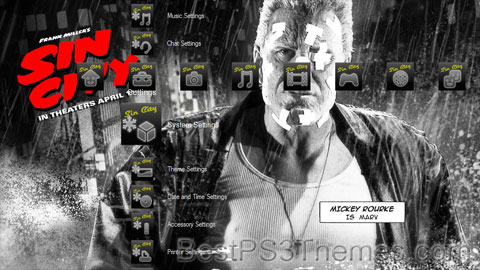
(6 backgrounds)
| Sin City | |||
|---|---|---|---|
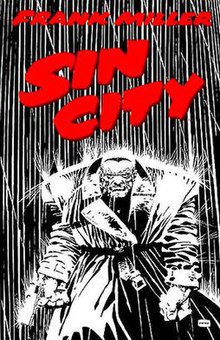 Cover of The Hard Goodbye showing Marv walking through the rain | |||
| First appearance | Dark Horse Presents Fifth Anniversary Special (April 1991) | ||
| Created by | Frank Miller | ||
| Publication information | |||
| Publisher | Dark Horse Comics | ||
| |||
| Formats | Original material for the series has been published as a strip in the comics anthology(s) Dark Horse Presents and a set of limited series, graphic novels, and one-shot comics. | ||
| Genre | Crime fiction, neo-noir, thriller | ||
| Publication date | April 1991 – 2000 | ||
| Main character(s) | Marv John Hartigan Gail Dwight McCarthy Nancy Callahan The Roark Family Wallace Miho | ||
| Creative team | |||
| Writer(s) | Frank Miller | ||
| Artist(s) | Frank Miller | ||
| Reprints | |||
| Collected editions | |||
| The Hard Goodbye | ISBN 1-59307-293-7 | ||
| A Dame to Kill For | ISBN 1593072945 | ||
| The Big Fat Kill | ISBN 1593072953 | ||
| That Yellow Bastard | ISBN 1593072961 | ||
| Family Values | ISBN 159307297X | ||
| Booze, Broads & Bullets | ISBN 1593072988 | ||
| Hell and Back | ISBN 1593072996 | ||
Sin City is a series of neo-noir comics by American comic book writer-artist Frank Miller. The first story originally appeared in Dark Horse Presents Fifth Anniversary Special (April 1991), and continued in Dark Horse Presents #51–62 from May 1991 to June 1992, under the title of Sin City, serialized in thirteen parts. Several other stories of variable lengths have followed. The intertwining stories, with frequently recurring characters, take place in Basin City.
A film adaptation of Sin City, co-directed by Robert Rodriguez and Frank Miller, was released on April 1, 2005. A sequel, Sin City: A Dame to Kill For, was released on August 22, 2014.
Writer-artist Frank Miller rose to fame within the American comics industry with his 1981–1983 work on Marvel Comics' Daredevil, and the 1986 DC Comics miniseries The Dark Knight Returns, both of which exhibited subtle elements of film noir.[1] Miller's venture into the film noir genre deepened with his creator-owned series Sin City, which began publishing in serialized form in the Dark Horse Comics anthology series Dark Horse Presents #51–62. The story was released in a trade paperback and later re-released in 1995 under the name Sin City: The Hard Goodbye.
In a 2016 interview with the Kubert School, Miller explained his inspiration for Sin City thus:
I've been a fanatic for a long time for old crime movies and old crime novels. But it started with the movies. And the old Cagney movies. Bogart and all that. I loved just how the morals of the stories are. They're all about right and wrong. But in Sin City in particular I wanted them all to happen to in a world where virtuous behavior was rare, which greatly resembled the world I lived in. It's kinda like the old Rolling Stones song, where every cop's a criminal, and all the sinners are saints, where the lowlifes would often be heroic, and the most stridently beautiful and sweet women would be prostitutes. I wanted it to be a world out of balance, where virtue is defined by individuals in difficult situations, not by an overwhelming sense of goodness that was somehow governed by this godlike Comics Code.[2]
The film noir influence on the series' artwork[1][3][4][5] is seen in its use of shadow and stark backgrounds. Black and white are the sole colors most of the time, with exception of red, yellow, blue, and pink, of which limited use is made in some stories to draw attention to particular characters.[1][6]
The writing style also draws heavily on detective and crime pulp fiction.[3][7][8]
Miller's Sin City work challenges some conventions of comic book form. The letters of onomatopoeic words like "blam" are often incorporated into scenes via lighting effects, or are suggested by the negative space between panels, or are created by the outline of the panels themselves. This is especially evident in early "yarns," such as The Hard Goodbye, which were more experimental.[9]
On April 28, 2022, it was officially announced that Miller was launching the comic book publishing company Frank Miller Presents (FMP), with one of his initial contributions being a Western tale set in Sin City's past, titled Sin City 1858.[10]

Basin City, almost universally referred to by the nickname "Sin City", is a fictional town in the Western United States. The climate is hot and arid, although Sacred Oaks[clarification needed] is characterized as being heavily wooded. A major river runs through the city, which has an extensive waterfront. Usually twice a year, a major downpour comes, and the city is prone to heavy snowfall in the winter. Desert lizards and palm trees are common, while tar pits, desert areas, mountain ranges and flat farmland make up the landscape around the city.[citation needed]
The Basin City Police Department are more or less along the lines of paramilitary or SWAT, as they have to deal with incredibly high crime rates among criminals and civilians alike, which is why they have access to what most would consider "heavy weaponry" and full body armor. Those who make up the force have been described as commonly being lazy, cowardly and/or corrupt. Only a handful of the cops are honest, though frequently the wealthy of the city bribe the corrupt members of the police into performing their duty (usually as a result of some crime being committed or threatened against a member of their family).[citation needed]
During the California Gold Rush, the Roark family "imported" a large number of attractive women to keep the miners happy, making a fortune and turning a struggling mining camp into a thriving, bustling city. Over the years, as the Roark family migrated into other areas of business and power, these women ended up forming the district of Old Town, the prostitute quarter of the city where they rule with absolute authority. In addition, the people charged with governing the city, most of them from the Roark line, remained in power for generations, running it as they saw fit.[citation needed]
As the various yarns progress, the audience gradually becomes familiar with key locations in and around Basin City:
Because a large majority of the residents of Basin City are criminals, there are several organizations and cartels central to the stories who are vying for monopoly over the various criminal enterprises in the city. Listed below are crime syndicates, gangs and other low-lifes who figure heavily in the Sin City mythos.
The Basin City Police Department: So deep does corruption and criminality run in Basin City that even their police officers qualify as a gang of paid thugs, turning a blind eye to the affairs of those too poor to pay them off. Few among them are considered incorruptible; even the honest officers are unable (or unwilling) to curtail the criminal actions of the dishonest ones. Notable characters in the series who are police include Detective John Hartigan, his partner Bob, Lieutenants Jack Rafferty and Mort, Commissioner Liebowitz, and Officers Manson and Bundy from Hell and Back.
Roark family: A dynasty of corrupt landowners and politicians whose influence over Basin City has stretched as far back as the days of the Old West. Famous Roarks of this generation include a senator, a cardinal, an attorney general, and Roark Junior, 'That Yellow Bastard'.
The Girls of Old Town: Populating the region of Basin City known as Old Town is a group of women in the world's oldest profession, having made a truce with the cops to allow them to govern and police themselves. As of A Dame to Kill For, they were led by the twins, Goldie and Wendy.
Wallenquist Organization: A powerful crime syndicate led by Herr Wallenquist, a mysterious crime lord with a broad range of criminal enterprises to his name. Although they are one of the city's two "normal" criminal organizations, the Wallenquist management seems to be the most peaceful and forgiving of the various leaders. It is unknown which crime rings they hold.
Magliozzi Crime Family: The undisputed heads of the local Cosa Nostra, the Magliozzi family seems to be the purest example of "true" Mafia lifestyle. While they appear in only one story, it is hinted that the Mafia influence in Basin City's underworld is a lot larger than just their family and that there are more families.
Other groups that have been seen or mentioned in the comics include:
Tong gangsters: Mentioned, but not seen as of A Dame to Kill For. Miho's life was saved by Dwight when he secretly protected her during a fight with several Tong gangsters in a dark alleyway.
White slavers: Mentioned, but not seen as of A Dame to Kill For. Led by a man named Manuel, whose brothers were also involved. Were "taken care of" by Dwight prior to the events of A Dame to Kill For.
Irish mercenaries: Seen during The Big Fat Kill, most of them are evidently former IRA members, as implied by one of the mercenaries referring to his glee at blowing up a public house (British pubs were targeted by the IRA). All are killed by Dwight and Miho.
These are the individual stories, usually referred to as "yarns," set in Frank Miller's Sin City universe.
The stories have been collected into a number of trade paperbacks and hardcover editions. There is also a collection of art, The Art of Sin City.
In 2016, Dark Horse Comics released an ambitious, oversized edition titled Frank Miller’s Sin City The Hard Goodbye Curator’s Collection.[11] This 15 x 21 inch book reprints the entire first storyline, scanned and reproduced exactly from the original art at 1:1 size. When referencing the production process in an interview with Michael Dooley for Print Magazine, editor/designer John Lind gave the anecdote “When Frank and I first reviewed some of the scanned pages from Sin City, he pulled one aside and said, ‘You can see details in some of the scans where you can tell what the humidity was like when I was lettering because you can see the smudging from my hand.’ That type of reaction represents the level of detail I'm working hard to achieve with the production.[12]
| Name | Contents | ISBN |
|---|---|---|
| The Hard Goodbye | Episodes #1–13 of 13 from Dark Horse 5th Anniversary Special and Dark Horse Presents issues #51–62 | ISBN 1-59307-293-7 |
| A Dame to Kill For | Issues #1–6 of 6 | ISBN 1-59307-294-5 |
| The Big Fat Kill | Issues #1–5 of 5 | ISBN 1-59307-295-3 |
| That Yellow Bastard | Issues #1–6 of 6 | ISBN 1-59307-296-1 |
| Family Values | 128-page original graphic novel | ISBN 1-59307-297-X |
| Booze, Broads, & Bullets | A number of one-shots | ISBN 1-59307-298-8 |
| Hell and Back | Issues #1–9 of 9 | ISBN 1-59307-299-6 |
| Name | Contents | Release Date | ISBN |
|---|---|---|---|
| Frank Miller's Sin City Library Set Vol. 1 | The Hard Goodbye, A Dame to Kill For, The Big Fat Kill and That Yellow Bastard | December 2005 | 978-1-59307-421-0 |
| Frank Miller's Sin City Library Set Vol. 2 | Family Values, Booze, Broads and Bullets, Hell and Back, and The Art of Sin City | June 2006 | 978-1-59307-422-7 |
| Big Damn Sin City | The Hard Goodbye, A Dame to Kill For, The Big Fat Kill, That Yellow Bastard, Family Values, Booze, Broads and Bullets, Hell and Back, and The Art of Sin City | June 2014 | 978-1-61655-237-4 |
| Frank Miller's Sin City Vol.1: The Hard Goodbye Curator's Edition | The Hard Goodbye scanned from the original artwork in Frank Miller's archives and reproduced at full size. Introduction by Robert Rodriguez, with an afterword by Mike Richardson and an interview about the artistic process with Frank Miller. | August 2016 | 978-1-50670-070-0 |
| Frank Miller's Sin City Vol.1: The Hard Goodbye Deluxe Edition | Episodes #1–13 of 13 from Dark Horse 5th Anniversary Special and Dark Horse Presents issues #51–62 | November 2021 | 978-1-50672-837-7 |
| Frank Miller's Sin City Vol.2: A Dame to Kill For Deluxe Edition | Issues #1–6 of 6 | December 2021 | 978-1-50672-838-4 |
| Frank Miller's Sin City Vol.3: The Big Fat Kill Deluxe Edition | Issues #1–5 of 5 | February 2022 | 978-1-50672-839-1 |
| Frank Miller's Sin City Vol.4: That Yellow Bastard Deluxe Edition | Issues #1–6 of 6 | May 2022 | 978-1-50672-840-7 |
| Frank Miller's Sin City Vol.5: Family Values Deluxe Edition | 128-page original graphic novel | June 2022 | 978-1-50672-841-4 |
A film adaptation of Sin City, co-directed by Robert Rodriguez and Frank Miller, was released on April 1, 2005. A sequel, Sin City: A Dame to Kill For, was released on August 22, 2014.
Dimension Films planned to develop a soft reboot of the series for television; Stephen L’Heureux who produced the second film was to oversee the series with Sin City creator Frank Miller.[13] The new TV series would feature new characters and timelines and be more like the comics rather than the films.[14] On November 15, 2019, Legendary Pictures bought the rights for the television series.[15]
Iron Man theme by Louxx
Download: IronMan.p3t
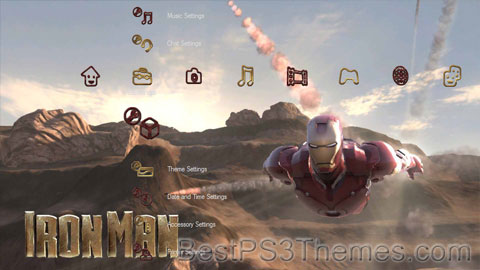
(3 backgrounds, HD only)
| Tony Stark Iron Man | |
|---|---|
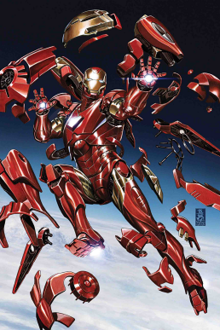 | |
| Publication information | |
| Publisher | Marvel Comics |
| First appearance | Tales of Suspense #39 (December 1962) |
| Created by | |
| In-story information | |
| Full name | Anthony Edward Stark |
| Place of origin | Long Island, New York |
| Team affiliations | |
| Partnerships | |
| Abilities |
|
Iron Man is a superhero appearing in American comic books published by Marvel Comics. Co-created by writer and editor Stan Lee, developed by scripter Larry Lieber, and designed by artists Don Heck and Jack Kirby, the character first appeared in Tales of Suspense #39 in 1962, and received his own title with Iron Man #1 in 1968. Shortly after his creation, Iron Man became a founding member of the superhero team, the Avengers, with Thor, Ant-Man, the Wasp, and the Hulk. Iron Man stories, individually and with the Avengers, have been published consistently since the character's creation.
Iron Man is the superhero persona of Anthony Edward "Tony" Stark, a businessman and engineer who runs the weapons manufacturing company Stark Industries. When Stark was captured in a war zone and sustained a serious heart wound, he built his Iron Man armor and escaped his captors. Iron Man's suits of armor grant him superhuman strength, flight, energy projection, and other abilities. The character was created in response to the Vietnam War as Lee's attempt to create a likeable pro-war character. Since his creation, Iron Man has been used to explore political themes, with early Iron Man stories being set in the Cold War. The character's role as a weapons manufacturer proved controversial, and Marvel moved away from geopolitics by the 1970s. Instead, the stories began exploring themes such as civil unrest, technological advancement, corporate espionage, alcoholism, and governmental authority.
Major Iron Man stories include "Demon in a Bottle" (1979), "Armor Wars" (1987–1988), "Extremis" (2005), and "Iron Man 2020" (2020). He is also a leading character in the company-wide stories Civil War (2006–2007), Dark Reign (2008–2009), and Civil War II (2016). Additional superhero characters have emerged from Iron Man's supporting cast, including James Rhodes as War Machine and Riri Williams as Ironheart, as well as reformed villains, Natasha Romanova as Black Widow and Clint Barton as Hawkeye. Iron Man's list of enemies includes his archenemy the Mandarin, many supervillains of communist origin, and many of Stark's business rivals.
Robert Downey Jr. portrayed Tony Stark in Iron Man (2008), the first film of the Marvel Cinematic Universe, and continued to portray the character until his final appearance in Avengers: Endgame (2019). Downey's portrayal popularized the character, elevating Iron Man into one of Marvel's most recognizable superheroes. Other adaptations of the character appear in animated direct-to-video films, television series, and video games.
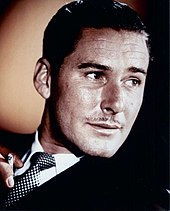
Following the success of the Fantastic Four in 1961 and the subsequent revival of American comic books featuring superheroes, Marvel Comics set about creating new superhero characters. Stan Lee developed the initial concept for Iron Man.[1] He wanted to design a character who should be unpalatable to his generally anti-war readers, but to make them like the character anyway.[2] Iron Man was created in the years after a permanent arms industry developed in the United States, and this was incorporated into the character's backstory.[3] The character was introduced as an active player in the Vietnam War. Lee described the national mood toward Vietnam during Iron Man's creation as "a time when most of us genuinely felt that the conflict in that tortured land really was a simple matter of good versus evil".[4]
Larry Lieber developed Iron Man's origin and wrote the first Iron Man story, while Jack Kirby and Don Heck were responsible for the initial design.[1][5] Lee modeled Iron Man after businessman Howard Hughes, invoking his physical appearance, his image as a businessman, and his reputation as an arrogant playboy.[6] Kirby and Heck then incorporated elements of the actor Errol Flynn's physical appearance in the design.[7] When first designing the character, Lee wanted to create a modernized Arthurian knight.[8] Kirby initially drew the Iron Man armor as a "round and clunky gray heap", and Heck modified the design to incorporate gadgets such as jets, drills, and suction cups.[9][10] The Iron Man character was created at a time when comic book characters were first depicted struggling with real life problems, and his heart injury was an early example of a superhero with a physical disability.[11]
Iron Man's earliest stories were published in the monster-themed anthology series Tales of Suspense. Marvel premiered several superheroes this way in the 1960s as superhero comics became more popular than traditional science-fiction and horror comics.[9][12] Iron Man's first appearance, "Iron Man is Born!", appeared in Tales of Suspense #39, released in December 1962 with a March 1963 cover date.[12] Though the Iron Man armor was gray in its first appearance, Marvel changed it to gold because of issues with printing.[5] Lee initially delegated the writing duties to other creators at Marvel, but he felt their work was substandard; as with his other characters, Lee reclaimed control of Iron Man so he could write the stories himself.[13]
Heck continued as the primary Iron Man artist until 1965, as Kirby had obligations to other Marvel properties.[9][10] As part of a shuffling to match artists with the characters they were most suited for, Steve Ditko became the artist for Iron Man.[14] Ditko was responsible for only three issues in late 1963, but in this time he redesigned Iron Man's suit from fully gold to the red and gold color scheme that became the character's primary image.[15] Iron Man's recurring nemesis, the Mandarin, first appeared shortly after in Tales of Suspense #50 (1964).[16] By this time, the science-fiction and horror stories were phased out, and Tales of Suspense ran only Iron Man and Captain America stories.[12]
Once Marvel's distributor allowed the company more monthly releases, The Avengers (1963) was developed as a new comic book series.[17] Iron Man was one of the five characters who formed the titular superhero team.[18] By 1965, the difficulty of maintaining continuity between The Avengers and the members' solo titles prompted Lee to temporarily write the original cast out of The Avengers, including Iron Man.[19]
For the first five years of publication, Iron Man represented the United States in Cold War allegories.[4][20] Growing opposition to the American involvement in Vietnam prompted a shift in Iron Man's characterization, which was part of a larger push by Marvel in the late 1960s to be more apolitical.[4][21] Over the years, the letters to the editor column in several issues saw extensive political debate.[22] Lee shifted the stories' focus to espionage and domestic crime, incorporating Marvel's fictional intelligence agency S.H.I.E.L.D. He also incorporated the villains of other Marvel heroes, avoiding Iron Man's primarily communist rogues' gallery and rewriting some of Iron Man's communist villains to have personal motivations independent of their communist allegiances.[23]
Iron Man was one of several characters whom Marvel gave a full-length dedicated series in 1968.[24] Marvel combined the final issues of Tales of Suspense and the Sub-Mariner's Tales to Astonish into a one-shot special, Iron Man and Sub-Mariner.[25] Iron Man then began its run under writer Archie Goodwin.[26] Goodwin reintroduced political themes slowly over the following years, with a focus on domestic issues like racial conflict and environmentalism rather than geopolitics.[27]
I don't feel Tony Stark is a dinosaur, a creature unable to change before the weight of time crushes him aside. Yeah, it is hard in 1977 to praise a millionaire industrialist, playboy and former munitions-manufacturer—but it isn't impossible to change that image. Which is what I plan to do.
Bill Mantlo, Iron Man #100[28]
When Goodwin became Marvel's editor-in-chief, he assigned Gerry Conway as the writer for Iron Man.[29] Conway was the first of several writers in a four-year effort to reform Iron Man, beginning in 1971, with stories that directly addressed the character's history as a weapons manufacturer.[30] These stories were especially prominent during a run by Mike Friedrich, in which corporate reform of Stark Industries was a recurring subplot.[31]
Iron Man was one of several Marvel characters who declined in popularity during the 1970s, and the series went a period of time without a dedicated writer until Bill Mantlo took over in 1977.[32] The following year, David Michelinie and Bob Layton took charge of the series, beginning with issue #116.[33][34] While inking the series, Layton used issues of GQ, Playboy, and electronics catalogues as visual references,[35] which he and Michelinie used to stay informed on developments in real world technology so the Iron Man armor would always be a more advanced version of what existed.[34] Layton was inspired by the vast collection of specialized outfits used by Batman when designing Iron Man's various armors.[36]
In Iron Man #117 and #118 (1978), Michelinie and Layton replaced many elements that developed over the series' run: they removed Iron Man's romantic interest Whitney Frost and Stark's robotic Life Model Decoy doubles, and they had Stark move to a different home.[37] They introduced Iron Man's new romantic interest, Bethany Cabe, as a feminist character who worked as his bodyguard.[38] The largest change they made was to make Iron Man an alcoholic, an unprecedented move for a major comic book hero, which led to the "Demon in a Bottle" story arc that ran from issues #120 to #128 (1979).[39] At the same time, they introduced the character Justin Hammer, who provided financial backing for several Iron Man villains.[40]
In the 1980s, writers for Iron Man focused on the character's role as a businessman, reflecting the economic changes associated with Reaganomics, and many of his challenges involved threats to his company.[41] Denny O'Neil was put in charge of Iron Man beginning with issue #158 (1982). His run explored Stark's psychology, having him relapse into alcoholism and suffer at the hands of business rival Obadiah Stane.[36] O'Neil wrote Stark out of the role entirely beginning with issue #170 (1983), having him temporarily retire as Iron Man and replacing him with his ally James Rhodes.[42] Stark was relegated as a side character until he returned to heroism in Iron Man #200 (1985).[43]
The 1987 "Armor Wars" story arc followed Iron Man as he reclaimed his technology, which Justin Hammer distributed to several villains.[44] This story blended the character's superhero and businessman aspects more directly when Stark sought legal recourse against his rivals.[41] Michelinie and Layton returned to the series with issue #211 (1986), and they again experimented with variations on the Iron Man armor.[45]
In 1990, Michelinie and Layton handed the series over to John Byrne, one of the most highly-regarded comic book writers at the time. He wrote three story arcs across twenty issues: "Armor Wars II" (which had already been announced by Michelinie and Layton), "The Dragon Seed Saga", and "War Games".[46] Byrne revisited Iron Man's opposition to communism but portrayed it as less of a threat,[47] and he rewrote Iron Man's origin to remove references to communism and the Vietnam War. He lost interest in the series by 1992 as his collaborators John Romita Jr. and Howard Mackie had moved on to other projects.[46] Iron Man's supporting character War Machine was spun off into his own comic book series in 1994.[48]
By the 1990s, the Iron Man series rejected broader ideology, and individualist values replaced Stark's allegiance to American democracy for its own sake. He remained anti-communist, reiterating his support for democracy and refusing to do business in China following the Tiannamen Square Massacre in 1989.[49] The absence of Cold War politics was not immediately replaced by another theme, and post-Cold War Iron Man stories often explored different ideas regarding technology for a short time before moving on.[50] When terrorism became more prominent in the public mind, writers shifted Iron Man's symbolism from anti-communism to anti-terrorism.[51]
As part of a company-wide reorganization in 1996, Marvel's major characters, including Iron Man, were given to former Marvel writers Jim Lee and Rob Liefeld in a profit-sharing agreement. Lee and Liefeld were given charge of the "Heroes Reborn" branding that renumbered Marvel's long-running periodicals at issue #1.[52] This new Iron Man series, labeled volume two, was set in an alternate universe created during the "Onslaught" event. It ran for thirteen issues, written by Lee and Scott Lobdell and drawn by Whilce Portacio.[53][54] The following year, Marvel introduced the "Heroes Return" event to bring the characters back from the alternate universe, which again reset characters such as Iron Man to issue #1.[55][56] Kurt Busiek beamce the writer for volume three while Sean Chen was the artist.[53][57]
When the Ultimate Marvel imprint was created with reimagined versions of Marvel's characters, an alternate Iron Man appeared in 2002 with the Ultimates, the imprint's adaptation of the Avengers.[58] Marvel released a five issue limited series, Ultimate Iron Man, featuring this character in 2005.[59]
Iron Man represented an attempt to define what a superhero was in the 21st century, following the September 11 attacks, implicitly likening the fear of terrorism to the fear of unregulated super-powered beings.[60] In 2004, Iron Man was a major character in the Avengers Disassembled event and subsequently became a founding member of the New Avengers.[61] Iron Man volume four began in 2005,[53] with Warren Ellis as the writer and Adi Granov as the artist. Its first story arc, "Extremis", saw Iron Man upgrade his body directly through the Extremis virus, giving him direct control over a biological armor.[59] The volume's first 14 issues carried the Iron Man title, while issues #15–32 (2007–2008) were titled Iron Man: Director of S.H.I.E.L.D.[53]
Iron Man led the pro-registration faction during the 2006 Civil War crossover event by Mark Millar and Steve McNiven.[62] In an allegory for the Patriot Act and government surveillance, Iron Man's pro-registration faction represented conservative support for government surveillance in the name of security and stood against Captain America's anti-registration faction that represented individualism and liberal opposition to government surveillance.[63] Iron Man believed in pragmatically choosing the lesser of two evils, whereas Captain America held an idealist approach, and both held these positions at great personal cost.[64] While Marvel was neutral between the characters, readers overwhelmingly saw Iron Man as the villain, being the stronger force that the underdog had to overcome.[65][66]
Iron Man appeared with the Mighty Avengers in 2007,[67] and his characterization in this era leaned into his identity as a futurist.[68] Marvel restarted Iron Man's comic book run with Invincible Iron Man in 2008, written by Matt Fraction and drawn by Salvador Larroca.[69] This series launched around the same time as the film Iron Man premiered,[70] and the Marvel Cinematic Universe developed while this run was in publication.[69]
The Iron Man series reverted to the original numbering in 2011, when the overall 500th issue was published as Iron Man #500.[53] A concurrent series, Iron Man Legacy by Fred Van Lente, launched in 2010 leading up to the release of the film Iron Man 2.[70] Iron Man was then one of several characters whose series was relaunched at issue #1 with the Marvel Now! branding following the 2012 Avengers vs. X-Men event,[71] written by Kieron Gillen.[72] The 2014 "AXIS" event led into the Superior Iron Man series by Tom Taylor, featuring Iron Man with a new reversed personality.[73]

A new Invincible Iron Man run written by Brian Michael Bendis and drawn by David Marquez began in 2015.[74] A simultaneous Iron Man series, International Iron Man, ran for seven issues in 2016 under Marvel's All-New, All-Different Marvel branding, also by Bendis. This series was meant to ensure Iron Man's status as a major character as All-New, All Different developed.[75] A second Civil War event in 2016 portrayed Iron Man as an advocate of free will against Captain Marvel's determinism.[76]
As part of a broader trend by Marvel Comics to substitute its main characters with a diverse cast of original characters in the 2010s, Iron Man was temporarily replaced by Ironheart, a teenaged African-American girl who reverse engineered the Iron Man armor, in 2016.[77] At the same time, the series Infamous Iron Man began publication with Dr. Doom as Iron Man.[78]
The series Tony Stark: Iron Man premiered in 2018 with the Fresh Start branding, written by Dan Slott and drawn by Valerio Schiti.[79] In 2020, Iron Man was relaunched in a new series, written by Christopher Cantwell and illustrated by CAFU, following the "Iron Man 2020" event. This series moved away from the developments and deviations made to Stark's character introduced over the previous years—including the more extravagant science fiction and soap opera plots—creating a clean slate for new story arcs in a traditional superhero setting.[80] The character was relaunched again in 2022 with Invincible Iron Man, written by Gerry Duggan and illustrated by Juan Frigeri.[81]
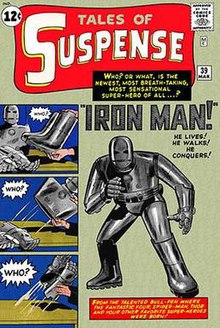
Anthony Edward "Tony" Stark was born in Long Island, New York. As a child, he inherited his family's business, Stark Industries, when his parents were killed in a car crash.[82] Developing equipment for the U.S. military, he travels to a war zone to conduct a weapons test when he triggers a booby trap. His heart is critically injured by shrapnel, and he is captured by the communist Wong-Chu, who demands Stark build him a weapon. Stark instead builds a suit of armor that sustains his heart, becoming Iron Man.[15][9] The war zone Stark visited was changed retroactively multiple times by different writers to correspond with the character's age, which is explained by a "sliding scale of continuity" in which the timing of significant events in the world of Marvel may change. This conflict was the Vietnam War for the first decades of Iron Man's publication history.
Flags of Our Fathers theme by Paja
Download: FlagsofOurFathers.p3t
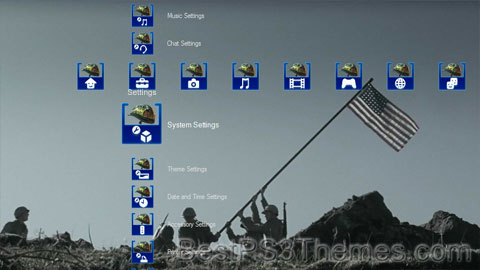
(1 background)
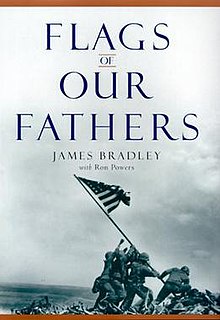 First edition cover | |
| Author | James Bradley Ron Powers |
|---|---|
| Language | English |
| Genre | Non-fiction |
| Publisher | Bantam Books |
Publication date | 2000 |
| Publication place | United States |
| Media type | |
| ISBN | 0-553-11133-7 |
Flags of Our Fathers (2000) is a book by James Bradley with Ron Powers about his father, Navy corpsman John Bradley, and five United States Marines, who were made famous by Joe Rosenthal’s Raising the Flag on Iwo Jima photograph. The story follows the lives of Bradley, Rene Gagnon, Ira Hamilton Hayes, Michael Strank, Harlon Henry Block, and Franklin Runyon Sousley. The five Marines were a part of Easy Company, 28th Marines, 5th Marine Division. Strank was a sergeant, Block was a corporal who reported to Strank, and the rest of the Marines were privates first class. John Bradley was a Navy corpsman who administered first aid to Easy Company.
The book is focused mainly on the Battle of Iwo Jima and the Marines who made the battle famous. The fighting on Iwo Jima was the only time in all of WWII in which US Marines suffered more casualties than the Japanese. Whilst the battle was still raging Rosenthal's photograph of the Marines was released and overnight gained the attention of the whole nation. In the following weeks Strank, Block, and Sousley were killed in battle and their families were notified. Bradley, Gagnon, and Hayes were sent on the 7th War Bond Drive and became public heroes. Even though the war for them was finished and they had raised money for their country, their fight was far from over. Many of the Marines had a very hard time moving on with life after their experiences in war and the book sheds light on some of these hardships.
Following a Marine investigation into the event it was determined that two of the six Marines featured in the book were not in the famous photograph. The men misidentified were Gagnon and Bradley, the men who were actually in the photo are Harold “Pie” Keller and Harold Schultz who were also a part of Easy Company. [1]
The book spent 46 weeks on The New York Times nonfiction bestseller list, spending six weeks at number one. [2]
Shortly after the book's publication, Steven Spielberg acquired the option for the film rights via DreamWorks Pictures. The film adaptation Flags of Our Fathers, which debuted in the U.S. on October 20, 2006, was directed by Clint Eastwood and produced by Eastwood, Steven Spielberg, and Robert Lorenz, with a screenplay written by William Broyles, Jr. and Paul Haggis.
Smallville versionD theme by Deemy
Download: Smallville_versionD.p3t

(3 backgrounds)
P3T Unpacker v0.12
Copyright (c) 2007. Anoop Menon
This program unpacks Playstation 3 Theme files (.p3t) so that you can touch-up an existing theme to your likings or use a certain wallpaper from it (as many themes have multiple). But remember, if you use content from another theme and release it, be sure to give credit!
Download for Windows: p3textractor.zip
Instructions:
Download p3textractor.zip from above. Extract the files to a folder with a program such as WinZip or WinRAR. Now there are multiple ways to extract the theme.
The first way is to simply open the p3t file with p3textractor.exe. If you don’t know how to do this, right click the p3t file and select Open With. Alternatively, open the p3t file and it will ask you to select a program to open with. Click Browse and find p3textractor.exe from where you previously extracted it to. It will open CMD and extract the theme to extracted.[filename]. After that, all you need to do for any future p3t files is open them and it will extract.
The second way is very simple. Just drag the p3t file to p3textractor.exe. It will open CMD and extract the theme to extracted.[filename].
For the third way, first put the p3t file you want to extract into the same folder as p3textractor.exe. Open CMD and browse to the folder with p3extractor.exe. Enter the following:
p3textractor filename.p3t [destination path]Replace filename with the name of the p3t file, and replace [destination path] with the name of the folder you want the files to be extracted to. A destination path is not required. By default it will extract to extracted.filename.